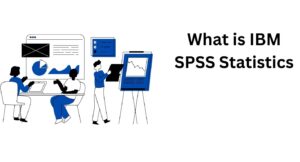In hypothesis testing, a critical value is a threshold or cutoff point that defines the boundary of the rejection region…
Understanding IBM SPSS Statistics: Definition, Key Features and Benefits
In today’s world, there has been an explosion in the amount of data generated daily. Recent statistics show that about 402.74 million terabytes of data are created each day. To harness the power of data, businesses and researchers need to identify the appropriate statistical tools for accurate data analysis. So, in this article, we uncover one of the most widely used statistical analysis tools called the IBM SPSS statistics.
What is IBM SPSS Statistics?
IBM SPSS Statistics is a powerful statistical software, which is widely used in research and businesses for statistical analysis. It is widely known for its robust capabilities and user-friendly interface that allow users to manage, analyze, and visualize data with ease. So, whether you need to perform simple descriptive statistics such as mean, and standard deviation, or complex statistical tests such as predictive modeling, then IBM SPSS Statistics is the most suitable statistical tool to use.
SPSS statistics has many users ranging from students, researchers, and business enterprises. Students benefit from its user-friendly interface, which helps them complete all their SPSS assignments without struggles. For researchers, IBM SPSS Statistics helps them conduct any statistical analysis with just a few clicks. Moreover, business enterprises leverage SPSS Statistics for accurate data analysis that supports data-driven decision-making.
Key Features of IBM SPSS Statistics
There are many features that make SPSS Statistics popular among researchers, students, and businesses. Some of these features include:
User-Friendly Interface
IBM SPSS Statistics is renowned for its user-friendly interface. Specifically, it allows users to perform statistical analysis through simple click procedures from the main menu. This makes it easier even for beginners to learn and perform statistical analysis. This means that you can learn how to perform various statistical analysis tests even without prior coding skills. In fact, if you’re just a beginner in data analysis and wondering where to start, then SPSS Statistics is a good start.
Data Management
Unlike other statistical software such as R Studio and Python, which require you to use complex coding for data management, data management in SPSS is straightforward. For instance, SPSS allows users to import data of various formats and from different sources with just a few clicks in the menu. Additionally, it allows you to perform data preprocessing methods such as merging, variable computation, and variable transformation quickly and easily. This saves users time that would otherwise be spent writing codes if using statistical tools such as Python, and R.
Statistical Analysis
SPSS also supports an extensive range of statistical procedures, which allow users to perform many statistical tests from the main menu. In particular, it supports procedures that help users summarize data using descriptive statistics, frequencies, inferential statistics, regression analysis, Correlation Analysis, etc. These features enable users to gain comprehensive insights into the data, regardless of the complexity of the statistical tests.
Data Visualization
Once you’ve performed statistical analysis using SPSS, you may need to support the findings with visuals. SPSS allows users to create appealing visuals for faster human perception and cognition. More importantly, its user-friendly nature helps users to create different types of visuals with simple drag-and-drop procedures. These visuals play a significant role in enhancing the communication of findings to the users. They also make the interpretation of the findings straightforward and insightful.
Advanced Modeling
If you’re looking for statistical software that can perform advanced statistical modeling without much struggle, then IBM SPSS Statistics is the right one. SPSS support features that allow users to add addons such as SPSS AMOS and SPSS Modeller, which are useful in performing advanced statistical modeling such as Structural Equation Modelling (SEM), Moderation Analysis, Mediation Analysis, etc. These advanced features are designed to make it easier to perform any type of statistical analysis without struggles. This makes SPSS a versatile tool for both beginners and advanced users.
Benefits of Using SPSS
There various benefits associated with using SPSS Statistics for data analysis. Some of these benefits include:
- Improved Decision-Making – With SPSS, business enterprises, and researchers can streamline the decision-making process because it makes the statistical analysis process easy and faster. This can consequently and significantly improve outcomes in various fields, from business operations to academic research.
- Increased efficiency – SPSS can process large datasets, perform complex calculations, and generate data analysis reports quickly. This makes it much more efficient in statistical analysis than other statistical tools such as R. This also gives the analysts and researchers more time to focus on other data analysis aspects such as interpretation of the results and presentation of the findings.
- Enhanced Research – SPSS Statistics is an invaluable tool for testing hypotheses, identifying trends, and drawing meaningful conclusions. Its comprehensive suite of statistical tests and procedures enables researchers to rigorously analyze data and validate their findings. This enhances the quality and credibility of research outcomes.
- Actionable Insights – One of the key benefits of SPSS is its ability to uncover hidden patterns and relationships within data. These insights can be pivotal for decision-makers, which allow them to act on findings that might not be immediately apparent through basic analysis.
Check out our comprehensive guide on the advantages of using SPSS for statistical analysis.
Final Take Away
- IBM SPSS Statistics: A user-friendly and powerful statistical software for data analysis in research and business.
- Key Features: Intuitive interface, effortless data management, extensive statistical procedures, and captivating data visualization tools.
- Benefits: Streamlined decision-making, increased efficiency, enhanced research capabilities, and actionable insights from data.
- Ideal For: Beginners, researchers, and businesses seeking a versatile tool for all their data analysis needs.
There isn’t a completely free version of SPSS Statistics. However, IBM offers a 30-days free trial to allow users to explore its capabilities before purchasing a license.
Yes, IBM often offers educational discounts for students and faculty. You can check the official website for current pricing and student offers.
You cannot download the full version of SPSS Statistics for free. However, you can get SPSS Statistics free trial from the official IBM website.
While there might not be a single comprehensive PDF manual, IBM provides extensive documentation and tutorials on their website. These resources cover various aspects of using SPSS Statistics, including user guides, getting started tutorials, and specific statistical procedures.







